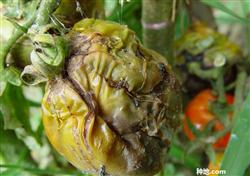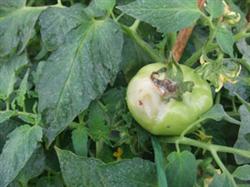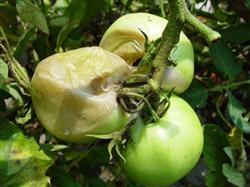How to prevent and control rotten tomato fruit

How to prevent and cure rotten tomato fruit? Please guide that in the process of production, tomatoes will suffer from a variety of fruit rot diseases, there are many causes of fruit rot, different prevention and control methods should be taken according to different conditions. Rotten fruit caused by soft rot. The disease generally occurs on the green fruit, the pericarp remains intact after the disease, but the internal pulp decays quickly, with a bad smell, easy to fall off, and the white fruit is formed when the diseased fruit is dried. Prevention and control methods: pruning and branching early to avoid overcast and rainy weather or before the dew is dry; timely control of fruit pests and reduce insect injuries; timely use of 150~200PPm agricultural streptomycin solution or 1000 times solution of Dixone before or at the initial stage of the disease to ensure that the solution is 50kg / mu to control the spread of the disease. Rotten fruit caused by solid rot. The disease occurs more often on the green fruit, the fruit epidermis often has brown or black-brown round disease spots, slightly sunken, touch the diseased parts hard, do not soften and rot, nor fall off. You can use 150 grams of 50% topiramate per mu and spray 50 to 75 kilograms of water. Rotten fruit caused by cotton rot. Cotton rot, also known as brown rot, mainly infects immature fruits. First of all, there are light brown spots with a smooth surface on the top or shoulder of the fruit, sometimes with a small amount of white mold, and then gradually form concentric wheel-shaped spots, which gradually become dark brown, the subcutaneous flesh also turns brown, and the whole fruit decays in the later stage. Prevention and treatment methods: diseased plants and fruits should be treated in time when the disease is found. In the early stage of the disease, spray 25% Ruidu 800 × 1000 times liquid, or spray with 64% disinfectant alum wettable powder 500 times liquid per mu, spray 2 times 3 times continuously, once every 4-7 days. Rotten fruit caused by anthrax. Mainly occurs on the mature fruit, the diseased part of the primary waterlogging-like transparent spots, enlarged into brown, slightly sunken, with concentric patterns, dense black spots on it, and secrete a reddish sticky substance, and finally the whole diseased fruit rotted or fell off. Prevention and control methods: the main prevention work is to do a good job of prevention, such as seed disinfection, rotation, spraying 700 × 800 times of disease-removing wettable powder every 10-12 days after 15-20 days of tomato planting. Or the Bordeaux liquid cross-use of 1 / 1 / 1 / 150 Bordeaux. Before or at the initial stage of the disease, 12% green EC EC 600 times or 75% chlorothalonil 600 times 800 times, or 50% carbendazim 800 times solution, has a better prevention and control effect. Rotten fruit caused by Fusarium. The disease mainly harms the mature fruit, the disease is light at first, then turns brown, has no obvious edge, and spreads all over the whole fruit after expansion. in rainy days or high humidity, the disease is dense with reddish cotton-like mycelium, resulting in fruit rot. Prevention and treatment: diseased fruit should be removed immediately to prevent the healthy fruit from coming into contact with the ground. 36% thiophanate methyl suspension 500 times solution can be sprayed before fruit coloring, which has a certain disease prevention effect. Rotten fruit caused by fruit cracking. The disease is caused by water imbalance, which is characterized by pericarp cracking at the stalk, which is easy to induce soft rot and fruit decay. Prevention and control methods: pay attention to drainage and irrigation to prevent the soil from being too dry or too wet, and 0.1% calcium nitrate solution foliar spray can be used, which has a certain control effect. Click to get more tomato planting techniques click to get more vegetable planting techniques
- Prev

What caused the rotten tomato fruit?
What causes rotten tomato fruit? Please introduce the rotten tomato fruit: first, the cause of the disease. The first cause of rotten tomato fruit is non-infectious physiological disease, mainly due to the lack of calcium and water imbalance in the fruit. Calcium deficiency in ⑴ fruits: tomato photosynthesis produces various organic acids, among which oxalic acid can cause moderate.
- Next

What causes rotten tomato fruit
What causes rotten tomato fruit? Please guide the rotten fruit of autumn tomato in fruiting period. the cause of the rotten fruit is related to three kinds of diseases, and the control should be strengthened. 1. Soft rot of rotten fruit tomato caused by soft rot is a bacterial disease, which mainly infects stems and fruits. When the fruit occurs, the skin is intact and bright, and the pulp is rotten and soft.
Related
- Where is it suitable to grow horseradish in China? it is expected to see the middle altitude horseradish in Alishan.
- How to prevent tomato virus disease reasonably? (Control methods included)
- Many people like to plant towel gourd on the balcony. What are the main points of this method and management?
- What crops can chili peppers be mixed with?
- Fertilization techniques and matters needing attention in Tomato
- What are the grafting techniques for peach seedlings in spring?
- Harm and control methods of root swelling disease of Chinese cabbage
- What are the pests of sweet potatoes? How to prevent and cure it?
- Symptoms, causes and Control methods of navel Rot in Tomato
- The cause of "Cucumber rotten bibcock" in Farmers' planting Cucumber and its Control Plan

